Tivoli Villa d'Este |
The fountains, the gardens
|
Tivoli Villa d'Este near Rome is included in the Unesco world heritage list. The masterpiece Italian-style garden, the innovative and tasteful landscaping, the bewildering 500 fountains, water jets and water plays (giochi d'acqua), the troughs and pools, the cascades, the grottoes, the views, made it a world-acclaimed sight, and an early much-copied model for the development of European gardens.
To hear the sound of the fountains, turn on the volume.
|
|
Overall view from the top of the Fountain of Neptune: the three large ponds, the gardens, and the palace on the hill |
The Neptune fountain, close view.
Behind it, the Water Organ Fountain. |
The villa and its wondrous gardens (Giardino delle meraviglie) were built from 1570 AD by Cardinal Ippolito d'Este, who illustrated in an exceptional manner the principles of Renaissance design and aesthetics. Since WWI it belongs to the Italian state. Due to particularly unfavorable environmental conditions, the restorations continued practically without interruption during the past twenty years (among these, the recent renovation of the Water Organ Fountain and of the Owl Fountain, or "Birdsong").
The Villa d'Este was commissioned by Cardinal Ippolito II d'Este, son of Alfonso I d'Este and Lucrezia Borgia, and grandson of Pope Alexander VI. He had been appointed Governor of Tivoli by Pope Julius III, with the gift of the villa.
After the disappointment of a failed bid for the papacy, he revived the magnificence of Hadrian's Villa (from which he drew many statues and marble used for construction).
The gardens were realized in the hanging cliffs of the Valle Gaudente (Gay Valley), with the aid of the painter-architect-archeologist Pirro Ligorio and Alberto Galvani, court architect-engineer of the Este family. |
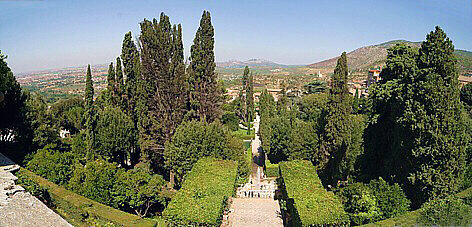 |
Sweeping view from the Villa's uppermost terrace down the main axis of the gardens, which fall away in a series of terraces in the Valle Gaudente (Gay Valley). |
They were assisted by Tommaso Chiruchi, one of the most skilled hydraulic engineers of the sixteenth century, and by a Frenchman, Claude Vernard, an experienced manufacturer of hydraulic organs.
Together they revived the Roman techniques of hydraulic engineering. They also brought back to life an ancient Roman tunnel diverting water from the Aniene river, to supply water to the sequence of fountains.
From 1605 Cardinal Alessandro d'Este began a program of interventions not only to restore and repair the vegetation and the waterworks, but also to create a new series of innovations to the layout of the garden and to the decorations of the fountains. Other works were carried out between 1660 - 1670; these involved no less a figure than Gianlorenzo Bernini. |
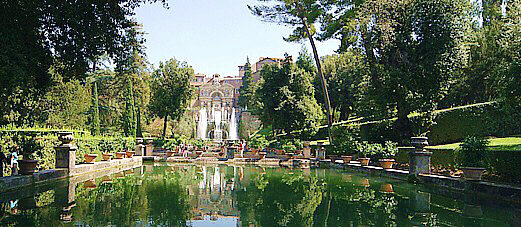 |
The three rectangular ponds, and in the distance the Fountain of Neptune and the Water Organ Fountain. |
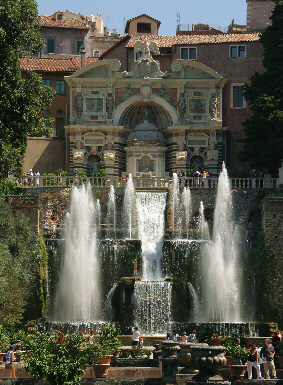 |
The Fountain of Neptune (left) is the largest and most spectacular fountain of the Tivoli Gardens. It includes two very high water jets, reaching the height of 14 meters, flanked by 6 smaller jets, or varying height, and originating in turn from a higher level of the fountain.
The fountain also includes a series of 7 water cascades, on different levels, shape and orientation.
On the terrace above you find the huge Water Organ Fountain, with a more sophisticated and complex design, with tabernacles, statues, columns, arches, and bas-reliefs, ending with a falcon statue, the symbol of the Este family.
The two fountains form a complex which is nearly 24 Mt. (80 Ft.) high, and 20 Mt. (67 Ft.) wide. The roar of the gushing water is deafening, but pleasant and somewhat musical at the same time.
|
The garden is organized in a combination of terraces and downward slopes. Central stairs lead down a wooded slope to three rectangular fishponds set on the cross-axis at the lowest point of the gardens, terminated at the right by the Water Organ fountain and by the Fountain of Neptune.
|
|
Crouds mesmerised by the Water Organ Fountain |
The Water Organ Fountain, close view.
|
It is said that the hydraulic-pneumatic technology of the famous 16th century Water Organ Fountain, a water-and-air-powered musical fountain, actually dates back to 1st-century Alexandria of Egypt. It was designed by Claude Vernard. The magnificently arched and pedimented fountain was the wonder of its era, replete with the statues of Diana, Apollo and other wondrous carvings, loops and arches, reviving
the myth of Orpheus. The Este's heraldic eagle dominates the fountain.
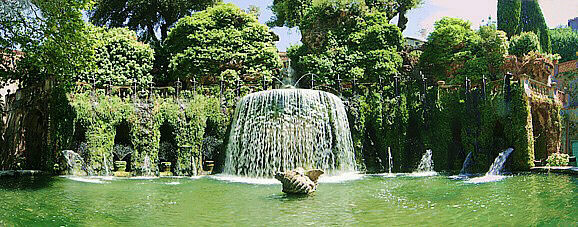 |
The Fontana dell'Ovato |
The Fontana dell'Ovato (Oval Fountain), also called Fontana di Tivoli (Tivoli Fountain), is near the Fountain of Neptune. The design is of Pirro Ligorio, while the rusticated arcade of the concave nymphaeum, peopled with marble nymphas, is by Giovanni Battista Della Porta. A visitor may walk behind the water through the arcade (currently this is not allowed). Above the nymphaeum you find three statues symbolizing the three rivers of Tivoli (Aniene, Erculaneo, Albuneo), and finally the sculpture of Pegasus.
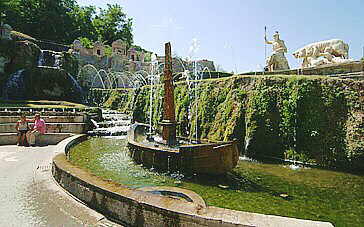
(Top): The Rometta fountain
(Right) Visitors staring the Fontana della Civetta (the Owl Fountain)
|
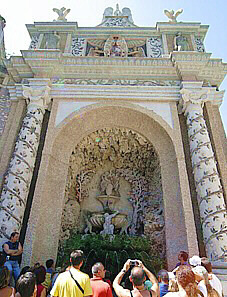 |
The Rometta fountain or little Rome, reproduces allusive key-parts of the Eternal City. You find the she-wolf with the twins,
Rome symbolized by a statue with armour, helmet and lance. At the feet of the statue, amid the water of a channel (the Tiber),
there is a boat representing the Tiberina island, where the first inhabitants of Rome settled. Unfortunately
the reproduction of the arch of triumph of Titus, of
Septimius Severus, and of Constantine were lost, and also that of the Trajan column.
In the Owl fountain a hydraulic device uses the fall
of water to move an artificial owl, making it approach the little bronze birds on
a branch. The birds are thus frightened and stop twittering. The chirping is realized by outgoing air from the beak of the
birds, pushed by the pressure of water in its own right. These devices were conceived to astonish the
hosts of the Cardinal.
Everything is placed between two columns on which grapevines and gold apples
rise, reminding once again the gold apples that Hercules embezzled to the
dragon Ladon in the garden of the Hesperides.
On the top in the center, the shield of Ippolito II is placed. It is supported by two angels and near them you find two feminine
statues. The highest part of the monument is adorned with two big
lilies and an enormous eagle, the symbols of the d'Este family.
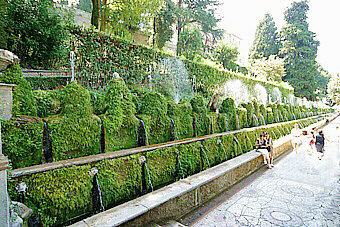
Parallel to the three rectangular ponds, and for their full length, you find the sequence of Le Cento Fontane (The Hundred Fountains).
Top and right: Le Cento Fontane |
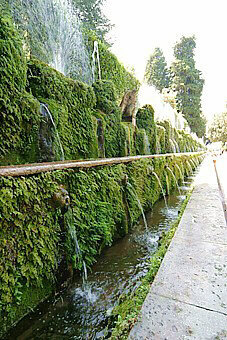 |
The Hundred Fountains
was chosen as location of different movies. It is a
tree-lined avenue with fountains leading from the Oval Fountain to the Fountain
of Rome (also known as "Rometta"). The fountains are structured on three levels in which the
waters of three "rivers" Albuneo, Aniene,
Ercolaneo slide symbolically.
They are the same rivers that "come down" from cliffs of the upper floor of the Fountain of the Ovato. They meet in the end in the Fountain of the Rometta symbolizing the Tiber.
The one hundred fountains have the shape of lilies, eagles, obelisks, small boats from which water comes out. The presence of lilies and eagles is connected to the coat of arms of the Este family.
In the middle of the avenue the vegetation opens into a wonderful balcony
with a dominating central view of the gardens.
From this balcony, through double circular
steps, one can reach the Fountain of the Dragons (by Ligorio). It was erected for a visit in 1572 of Pope Gregory XIII, whose coat of arms features a dragon. Water jets gush from the four dragons mouths, around a central jet.
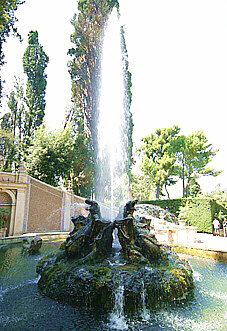
The Fontana dei Dragoni (The Dragons Fountain). |
The fountain of Diana of Ephesus, or Goddess of Fertility, stood in the central niche of the Water Organ fountain, but it was perceived to be too pagan and it was thus relocated in a rather hidden part of the gardens.
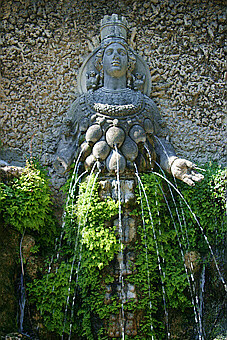
Fountain of Diana of Ephesus |
The palace
Built on the ruins of a Roman villa, it was first a Benedictine convent and then the Governor's Palace, and as such it was magnificently restored by Pirro Ligorio on commission of Ippolito d'Este.
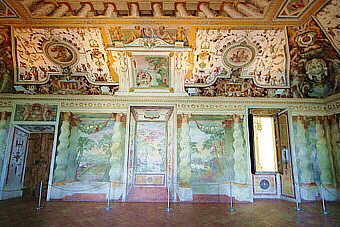 |
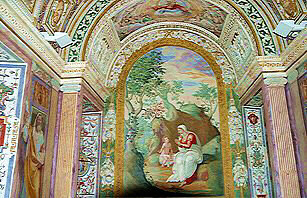 |
The grand Sala, the central hall, richly decorated, and with a spectacular view of the valley beneath. |
The chapel: the frescoes of the prophets are by Zuccari, while the "Madonna di Reggio" is by Ludovico Agresti. |
The rooms of the Palace were ambitiously decorated by the stars of the late Roman Mannerism, such as Livio Agresti and Federico Zuccari. The palace hosted the musician Franz Liszt (1811 - 1886), who composed Giochi d'acqua a Villa d'Este (Water plays at Villa d'Este) for piano while a guest here, and who in 1879 gave one of his final concerts.
Visiting Hours:
Opening 8.30 - closed one hour before sunset.
The ticket office closes one hour before the closing of the monument.
The Fontana della Civetta (Owl fountain) functions daily, from 10.00am, every two hours. The Fontana dell'Organo (Water Organ Fountain) works from 10:30am, every two hours.
The Villa is closed the following days: All Mondays, January 1st, May 1st, and December 25th. If Monday is a holiday, the monument will remain open and the weekly closure will then be postponed to the following business day.
Ticket prices:
From October 22, 2013: € 8.00 full price - reduced price € 4.00. Reduced price tickets apply for all European Union citizens between the ages of 18 and 24, and for permanent teachers of state schools (upon presentation of identity documents). There is free admission for all European Union citizens under 18 and over 65, upon presentation of identity documents.

Visit Rome | Rome panoramic views | Rome apartments and villas | Inquire | Rome travel guide | Rome map | Service | Resources
Roman Homes homepage |

